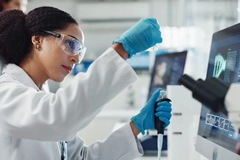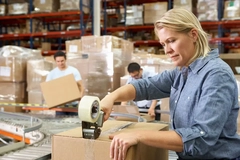INC-5.2: European Bioplastics reacts to frustrating UN Global Plastic Treaty outcome
We speak with Julie Pieters, European Bioplastics’ EU policy affairs manager, following the UN Environment Assembly’s final negotiating session (INC-5.2) on a Global Plastic Treaty.
Pieters, who took part in the talks as an observer, tells Packaging Insights that the negotiations’ outcome is undesirable and discusses its implications for Europe’s bioplastics industry.
How did the negotiations progress, and what are your thoughts on the outcome?
Pieters: The opening plenary led to optimism as it was brief, and consensus emerged that the time to act is now and that tangible negotiations should begin swiftly. Unfortunately, this optimism was short-lived. Starting with the first Contact Group meetings (technical meetings), negotiations stalled due to procedural issues and delaying tactics.
The positions of the high-ambition coalition and those of the like-minded countries (mainly oil producers) remained very far apart, and there was a lack of bridging proposals on the main points. There was hope that countries like the US and China would provide bridges, but this has not led to actual progress.
Crucial topics such as problematic plastic products (Article 3), supply (Article 6), and the financial solidarity mechanism (Article 11) are still very much non-consensual. Additionally, articles that were nearly finalized in Busan, like plastic product design (Article 5), have been completely reopened and are full of brackets.
On Wednesday, the chair proposed a new basis for negotiations that was not acceptable to the High Ambition Coalition. Twenty-four hours before the end of INC-5.2, negotiations were still ongoing. However, many bridges still needed to be built before an agreement could be reached.
The biggest question in the last few days was: Is it better to have a weak agreement than none at all?
 Pieters highlights bioplastics as a complementary tool within a broader circular economy strategy.Pieters: The final 24 hours of negotiations led to progress on certain politically difficult issues – such as for example the financial solidarity mechanism. However, despite the efforts of many, in the end, the text on the table could not find consensus. It seems a third part of the 5th session will be organized, although we left Geneva without an indication of time, place, and on the basis of which text negotiations will continue.
Pieters highlights bioplastics as a complementary tool within a broader circular economy strategy.Pieters: The final 24 hours of negotiations led to progress on certain politically difficult issues – such as for example the financial solidarity mechanism. However, despite the efforts of many, in the end, the text on the table could not find consensus. It seems a third part of the 5th session will be organized, although we left Geneva without an indication of time, place, and on the basis of which text negotiations will continue.
How did you envision the role of bioplastics in a global treaty?
Pieters: European Bioplastics strongly believes that certified bio-based, biodegradable, and compostable bioplastics are complementary instruments integral to achieving both plastic pollution reduction and climate neutrality.
Bioplastics support a circular bioeconomy, helping to transition away from fossil-based plastics while lowering CO2 emissions through substitution in key sectors such as agriculture or foodservice packaging. With proper certification and end-of-life systems, bioplastics add functional, sustainability-aligned options and should therefore be included in the treaty.
As there is no silver-bullet solution against plastic pollution, we want the treaty to promote more sustainable options, including bioplastics.
You supported including bioplastics in Articles 2, 3, and 5. What do these articles cover, and what are the next steps?
Pieters: Article 5 is on plastic product design, and it is the most appropriate anchor point. Bioplastics differ from conventional plastics in that they are either bio-based — offering a lower-carbon “better beginning of life” — or biodegradable/compostable — providing an alternative, improved end-of-life option. We believe they should be treated distinctly in the treaty so that states can invest in their research, development, and market uptake.
We also support their inclusion in the article on plastic products (previously Article 3). Bioplastics can substitute for more environmentally problematic plastics in a range of applications, contributing to the treaty’s overall ambition.
Finally, in Article 2, our intention was to ensure that, if a definition of recycling were adopted, it would explicitly include organic recycling. The treaty did not define recycling, so this point was less relevant.
How do you respond to concerns that including bioplastics in binding international law risks displacing reuse systems or plastic bans?
Pieters: Bioplastics are not a substitute for reduction, reuse, or bans. They are a complementary tool within a broader circular economy strategy. A strong treaty must take a full life-cycle perspective, combining legislation, innovation, and infrastructure to end plastic pollution.
European Bioplastics supports waste prevention and reuse wherever possible. However, in situations where reduction or reuse are not feasible, certified bio-based, biodegradable, and compostable materials have the potential to reduce reliance on fossil-based plastics while meeting strict sustainability criteria and can be organically, mechanically/ physically, or chemically recycled.
Given that bio-based plastics are often more expensive to produce than fossil-based alternatives, how do you imagine countries adopting these materials?
“Problematic” plastic products, supply, and financing, remain unaddressed, says Pieters.Peters: Bio-based plastics won’t replace every fossil plastic overnight, and they shouldn’t have to. Countries can adopt them where they add clear value — lower GHG emissions, better end-of-life options, or local feedstock use — while keeping a technology-neutral approach overall.
Costs are already converging as capacity scales, and the “real price” gap narrows further when you factor in the external costs of fossil plastics and the removal of inefficient subsidies. For lower-income countries, the most realistic pathway is targeted deployment in priority applications (for example, agriculture, food-contact, or organics-recycling systems), coupled with development finance, public procurement, and standards that ensure performance and safety.
European Bioplastics supports a just, inclusive transition: fit-for-purpose materials, investment in waste systems, and financing mechanisms that make solutions affordable where they are needed most.
Biodegradable and compostable plastics require specific recycling infrastructure. What steps is EUBP proposing to scale such infrastructure globally?
Pieters: Many countries lack any recycling infrastructure whatsoever, and, given that setting up organic recycling infrastructure requires far lower investments than that of mechanical or advanced recycling, starting with the set-up of organic recycling infrastructure is a logical first step.
This even more if you consider that biowaste often makes up somewhere between 40% and 60% of the overall municipal waste. At the end of the day, however, achieving a circular economy requires robust mechanical, chemical, and organic recycling infrastructure, as well as having access to this infrastructure.
We are advocating for harmonized standards and certification schemes, clear labeling to guide consumers and waste operators, and policy integration that mandates separate biowaste collection with acceptance of certified compostable plastics. We also call for targeted investment and incentives in industrial composting and anaerobic digestion facilities to ensure full-scale.











